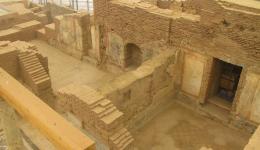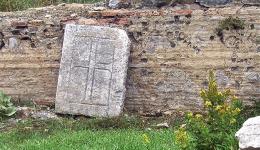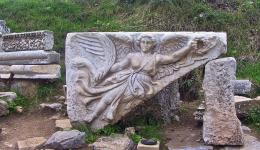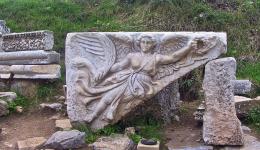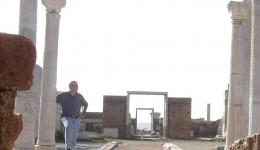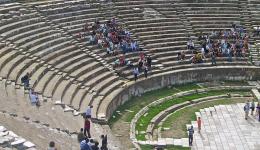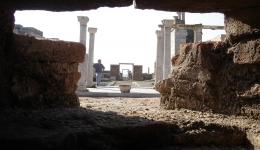Category:
Walking through Ephesus (in modern day Turkey), recently, was an incredible experience. It is ‘up and down’ terrain, situated in a long sloping valley between two mountains. The former bay and port is now silted in for about 6 kms to the modern Aegean seaside and the town of Kusadasi, where we stayed several nights as a locus for several day trips. When I think of Paul writing to the Ephesians of the love of God – its height and breadth and depth and width, I can now mind-picture the ‘geography’ of their locale, streets that wind and slope, and of the heights of the hills and the lows of the swamps and marshes — and of the long ditch and one huge pillar — which is all that remains of the Temple of Artemus – one of the 7 wonders of the ancient world.
We had our devotional there, sitting up in the stone theatre, very much like Toronto’s Rogers Centre (Skydome) but without the rails to protect you from tripping and rolling all the way down — where Christians were thrown to lions, or burned, or drowned for the entertainment of the crowds gathered — or there the city populace enjoyed a lovely theatre outing and performance of a Greek play or tragedy. It’s where the locals (threatened by the presence and effects of the message of this godly man — by the witness of St. Paul), shouted: “Great is Artemus” for over two hours. In fact, the Scripture says most of them didn’t even know why they had come together — such is a mob and often a crowd (and even some Baptist annual meetings). A colleague and fellow-traveller, Harry Gardener who shared the devotional, reminded us that ‘Paul came into Ephesus HOT’ – i.e. full of the Spirit and with the power and Presence of the Risen Christ in His life.
We walked down ancient ‘Roman-time’ streets and roads, the stones and pavement where Paul, and John and Mary (Jesus’ mother) walked — and Priscilla and Acquilla – and Apollos – through this city where Paul left Timothy to pastor the new and growting church — and also where walked, through the early decades and centuries of the Church, other Christians whose names and faithful witness is now lost to the ages, but not to God.
We looked around at the ruins and remains of what would then have been glistening marble, at the still intact walls and roofs – with it all still seeming so immense and so impressive. Large pillars, arches and stones reveal feats of architectural genius and beauty, in how they looked and how they were raised into their places. Past the agora, and the library of Celcius, and another, smaller theatre – through the brothel, ‘resting’ discretely at the public toilets row-ruins, surveying the road leading down to harbour and ancient piers, at the race-track – examining the shops and homes — entering houses that still crawl and stretch up the slopes beyond the street(protected by huge awnings that the Austrians have provided as they escavate and preserve still more.
They preserve, for example, huge houses, with mosaic floors and frescoes – and hot and cold water pipes, and fireplaces. These homes make yours, mine, look almost primitive. And it’s quite possible that Paul lived in, visited, preached and prayed, conducted services in these very homes. It changed ALL my thinking of what a ‘house church’ was in those ancient times.
It was stinking hot – sultry, humid and my nose and face was red and sore the next day. We grinned into each other’s cameras and gawked, wandered and wondered – but mostly we were lost in our own thoughts of how impossibly wonderful was the privilege of being there and as we surveyed it all and sought to take in and make sense of what it used to mean, has meant through the centuries, and now meannt to us – to even pass through those ancient walls and streets . . .
High on a hill was an ancient walled castle, built by the Crusaders in the Middle Ages, for this was a holy place in lots of ways, to Christian pilgrims, Crusaders, and to the weird and powerful Templar Order (who reverenced St. John to a fault – their ideals still have come down in enlightenment thought — and in some of Quebec’s national and independence-culture in St. Jean Baptiste Day, celebrated each year at the summer’s annual solstice.) So many configurations and factors and secrets, now hidden, almost occultic things — and pure orthodoxy too of course – flow from ancient Ephesus.
Beneath the hill and sprawling out, larger than any cathedral extant that I can think of, are the ruins of a church, cloister, walls and all, that was built after Constatine that Christianity was now to be ‘kosher’ — the religion of choice (imposed often more than offered), the state religion of the Roman world. The church was built around the tomb of St. John by the Emperor Justinian. We walked around here too, almost numb, taking pictures – pondering it all.
There was something hauntingly beautiful, eery even. about being at the tomb of St. John (where in fact the Pope will conduct mass later this month — as he will also at a Greek Orthodox church we also visited in Istanbul – this ‘breakthrough’ seeking to reverse the almost laughable and clumsy excommunication each of the other that harkens back to the 7th century and led to the first and until now split of the Orthodox and Roman Catholic branches of the Church).
I lingered there awhile and heard one of our group teasingly remark: – O sure, there are the group’s contemplatives still at John’s grave. Right; to be sure. And when they were out of sight, I knelt and crossed myself both ways (in the Roman and then the Orthodox style), feeling somehow that I wanted to do something external to express the deep pulsing of my heart and spirit – and I didn’t know what else to do, feeling as I did so moved. This brother, this Apostle who walked with the Saviour, who lived Him so much, who lived so faithfully with and for Him so long. He who cared for Mary, Jesus’ mother.
We stood then together in one of the church’s trancepts, by the ancient treasury, and when there was a break from the excellent history and religion commentary of our guide, I felt moved to say: “Listen now to some words from the Book that we all love (I Jn. 3:1 – 3): ‘How great is the love that the Father has lavished upon us — that we should be called the children of God — and that is what we are. The world does not know us because it did not know Him. Dear ones, now we are the children of God, and it does not yet appear what we shall be, but we know that — when He shall appear, we shall be like Him, for we shall see Him as He is. And everyone who has this hope in him (or her ) keeps himself (herself) pure.” We just stood and meditated and wondered, awhile — and then made our way together slowly back through the streets of Ephesus, and to our bus.
I can’t get over, nor can I comprehend, what it was that happened in the context of the whole trip – I cannot explain what it was really like in its personal, inner impact – beyond that of giving a mere geography or history lesson, or referring others as to a travel guide in some booklet. My pictures take head-on shots but cannot capture the 360 degrees of sense and the many layers and heights and depths (both physical and spiritual) of the experience. It was and will remain in my life a transforming experience. The impact born in Ephesus and throughout each aspect of trip – and the opportunity in itself is now to me another great example of the genius of CBM (Canadian Baptist Ministries) in making possible these STMSs (Short Term Mission experiences) that are so deeply life-changing, stirring, and so spiritually uplifting.



